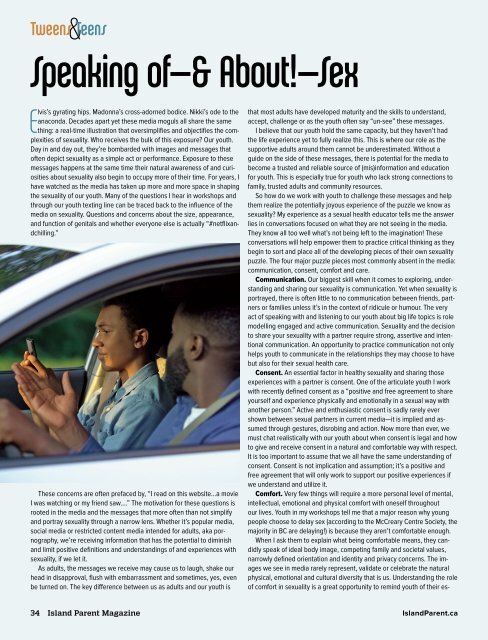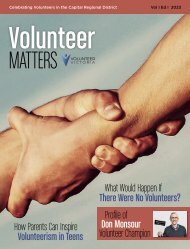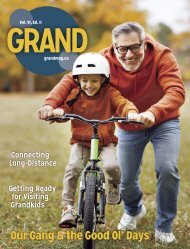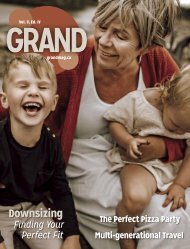Island Parent Pre-Summer 2023
Vancouver Island’s Parenting Resource for 35 Years • Explore the Island: A Region-by-Region Guide • Road Trip Food • Things to Do in June & July • Play On: Outdoor Games for Families • Seas, Trees & a Gentle Breeze • Tweens & Teens
Vancouver Island’s Parenting Resource for 35 Years • Explore the Island: A Region-by-Region Guide • Road Trip Food • Things to Do in June & July • Play On: Outdoor Games for Families • Seas, Trees & a Gentle Breeze • Tweens & Teens
Create successful ePaper yourself
Turn your PDF publications into a flip-book with our unique Google optimized e-Paper software.
Speaking of—& About!—Sex<br />
Elvis’s gyrating hips. Madonna’s cross-adorned bodice. Nikki’s ode to the<br />
anaconda. Decades apart yet these media moguls all share the same<br />
thing: a real-time illustration that oversimplifies and objectifies the complexities<br />
of sexuality. Who receives the bulk of this exposure? Our youth.<br />
Day in and day out, they’re bombarded with images and messages that<br />
often depict sexuality as a simple act or performance. Exposure to these<br />
messages happens at the same time their natural awareness of and curiosities<br />
about sexuality also begin to occupy more of their time. For years, I<br />
have watched as the media has taken up more and more space in shaping<br />
the sexuality of our youth. Many of the questions I hear in workshops and<br />
through our youth texting line can be traced back to the influence of the<br />
media on sexuality. Questions and concerns about the size, appearance,<br />
and function of genitals and whether everyone else is actually “#netflixandchilling.”<br />
These concerns are often prefaced by, “I read on this website…a movie<br />
I was watching or my friend saw….” The motivation for these questions is<br />
rooted in the media and the messages that more often than not simplify<br />
and portray sexuality through a narrow lens. Whether it’s popular media,<br />
social media or restricted content media intended for adults, aka pornography,<br />
we’re receiving information that has the potential to diminish<br />
and limit positive definitions and understandings of and experiences with<br />
sexuality, if we let it.<br />
As adults, the messages we receive may cause us to laugh, shake our<br />
head in disapproval, flush with embarrassment and sometimes, yes, even<br />
be turned on. The key difference between us as adults and our youth is<br />
that most adults have developed maturity and the skills to understand,<br />
accept, challenge or as the youth often say “un-see” these messages.<br />
I believe that our youth hold the same capacity, but they haven’t had<br />
the life experience yet to fully realize this. This is where our role as the<br />
supportive adults around them cannot be underestimated. Without a<br />
guide on the side of these messages, there is potential for the media to<br />
become a trusted and reliable source of (mis)information and education<br />
for youth. This is especially true for youth who lack strong connections to<br />
family, trusted adults and community resources.<br />
So how do we work with youth to challenge these messages and help<br />
them realize the potentially joyous experience of the puzzle we know as<br />
sexuality? My experience as a sexual health educator tells me the answer<br />
lies in conversations focused on what they are not seeing in the media.<br />
They know all too well what’s not being left to the imagination! These<br />
conversations will help empower them to practice critical thinking as they<br />
begin to sort and place all of the developing pieces of their own sexuality<br />
puzzle. The four major puzzle pieces most commonly absent in the media:<br />
communication, consent, comfort and care.<br />
Communication. Our biggest skill when it comes to exploring, understanding<br />
and sharing our sexuality is communication. Yet when sexuality is<br />
portrayed, there is often little to no communication between friends, partners<br />
or families unless it’s in the context of ridicule or humour. The very<br />
act of speaking with and listening to our youth about big life topics is role<br />
modelling engaged and active communication. Sexuality and the decision<br />
to share your sexuality with a partner require strong, assertive and intentional<br />
communication. An opportunity to practice communication not only<br />
helps youth to communicate in the relationships they may choose to have<br />
but also for their sexual health care.<br />
Consent. An essential factor in healthy sexuality and sharing those<br />
experiences with a partner is consent. One of the articulate youth I work<br />
with recently defined consent as a “positive and free agreement to share<br />
yourself and experience physically and emotionally in a sexual way with<br />
another person.” Active and enthusiastic consent is sadly rarely ever<br />
shown between sexual partners in current media—it is implied and assumed<br />
through gestures, disrobing and action. Now more than ever, we<br />
must chat realistically with our youth about when consent is legal and how<br />
to give and receive consent in a natural and comfortable way with respect.<br />
It is too important to assume that we all have the same understanding of<br />
consent. Consent is not implication and assumption; it’s a positive and<br />
free agreement that will only work to support our positive experiences if<br />
we understand and utilize it.<br />
Comfort. Very few things will require a more personal level of mental,<br />
intellectual, emotional and physical comfort with oneself throughout<br />
our lives. Youth in my workshops tell me that a major reason why young<br />
people choose to delay sex (according to the McCreary Centre Society, the<br />
majority in BC are delaying!) is because they aren’t comfortable enough.<br />
When I ask them to explain what being comfortable means, they candidly<br />
speak of ideal body image, competing family and societal values,<br />
narrowly defined orientation and identity and privacy concerns. The images<br />
we see in media rarely represent, validate or celebrate the natural<br />
physical, emotional and cultural diversity that is us. Understanding the role<br />
of comfort in sexuality is a great opportunity to remind youth of their es-<br />
34 <strong>Island</strong> <strong>Parent</strong> Magazine <strong>Island</strong><strong>Parent</strong>.ca
















